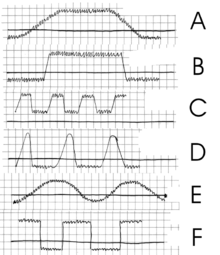Intermittent fever is a type or pattern of fever in which there is an interval where temperature is elevated for several hours followed by an interval when temperature drops back to normal.[1] This type of fever usually occurs during the course of an infectious disease.[2] Diagnosis of intermittent fever is frequently based on the clinical history but some biological tests like complete blood count and blood culture are also used. In addition radiological investigations like chest X-ray, abdominal ultrasonography can also be used in establishing diagnosis.[3][4]

a) Fever continues
b) Fever continues to abrupt onset and remission
c) Remittent fever
d) Intermittent fever
e) Undulant fever
f) Relapsing fever
Intermittent fever in malaria
editMalaria is a common cause of intermittent fever and it has following types.[5][6]
Quotidian fever
editBouts of fever occurring daily (24-hour periodicity) for a few hours, typical of Plasmodium falciparum.
Tertian fever
editFever occurs after an interval of two days (48-hour periodicity), typical of Plasmodium vivax and Plasmodium ovale.
Quartan fever
editFever occurs after an interval of three days (72-hour periodicity), typical of Plasmodium falciparum.
Examples
editInfectious causes of intermittent fever
editThe following are examples of infectious diseases that may feature intermittent fever.[7][8][9]
- Malaria
- Tuberculosis
- Sepsis
- Kala azar
- Borreliosis (Lyme disease)
- Rat-bite fever
- Epstein-barr virus
- Chronic meningococcemia.
Inflammatory causes of intermittent fever
editAdult-onset Still's disease is an inflammatory disease that may cause intermittent fever, characteristically a quotidian fever that spikes once or twice in the late afternoon to evening.[10]
Management
editAntipyretics like ibuprofen and paracetamol are used for fever and body aches.[11] Antibiotics are also used for any underlying infection. For treating malaria, anti-malarial drugs like quinine, chloroquine and primaquine are given.[12]
See also
edit- Continuous fever
- Relapsing fever
- Undulant fever
- Remittent fever
- Neutropenic fever
- Cyclic fever; called Pel–Ebstein fever in Hodgkin's lymphoma
References
edit- ^ Inayatullah, Muhammad; Nasir, Shabbir Ahmed (2016). Bedside Techniques: Methods of Clinical Examination (4th ed.). Paramount Books (Pvt.) Limited. ISBN 978-969-494-920-8.[page needed]
- ^ Le Moing V, Leport C (Jan 2002). "[Intermittent fever of infectious origin]". La Revue du Praticien. 52 (2). Rev Prat: 139–44. PMC 3257674. PMID 11915556.
- ^ Vidal, E; Liozon, E; Loustaud-Ratti, V (2002). "Prise en charge d'une fièvre intermittente chez l'adulte: Fièvres intermittentes" [Management of intermittent fever in the adult]. La Revue du Praticien (in French). 52 (2): 167–71. PMID 11915561.
- ^ Hachulla, E (2002). "Fièvre intermittente symptomatique des maladies inflammatoires: Fièvres intermittentes" [Symptomatic intermittent fever of inflammatory diseases]. La Revue du Praticien (in French). 52 (2): 160–66. PMID 11915560.
- ^ Wittern, R (1989). "Die Wechselfieber bei Galen" [Galen's intermittent fever]. History and Philosophy of the Life Sciences (in German). 11 (1): 3–22. JSTOR 23330279. PMID 2682735.
- ^ Ferri, Fred F. (2009). "Malaria". Ferri's Color Atlas and Text of Clinical Medicine. Elsevier Health Sciences. pp. 1159–61. ISBN 978-1-4160-4919-7.
- ^ Le Moing, V; Leport, C (2002). "Fièvres intermittentes d'origine infectieuse: Fièvres intermittentes" [Intermittent fever of infectious origin]. La Revue du Praticien (in French). 52 (2): 139–44. PMID 11915556.
- ^ Kameya, K; Tsuchiya, M; Mie, K (1975). "Butterfly-like erythematous lesions and intermittent fever: Miliary tuberculosis". Nihon Rinsho. Japanese Journal of Clinical Medicine. Spec No: 726–27, 1040–43. PMID 1240348.
- ^ Gräf, P; Börner, N; Reichert, M; Weilemann, L. S; Meyer, J (1988). "Intermittent fever attacks. Lyme disease without erythema chronicum migrans". Der Inrnist. 29 (11): 778–80. doi:10.1007/978-3-662-39609-4_126. PMID 3069790.
- ^ Gerfaud-Valentin, Mathieu; Jamilloux, Yvan; Iwaz, Jean; Sève, Pascal (2014). "Adult-onset Still's disease". Autoimmunity Reviews. 13 (7): 708–722. doi:10.1016/j.autrev.2014.01.058. PMID 24657513.
- ^ Perrott, David A; Piira, Tiina; Goodenough, Belinda; Champion, G. David (2004). "Efficacy and Safety of Acetaminophen vs Ibuprofen for Treating Children's Pain or Fever". Archives of Pediatrics & Adolescent Medicine. 158 (6): 521–26. doi:10.1001/archpedi.158.6.521. PMID 15184213.
- ^ d'Alessandro, Umberto (2009). "Existing antimalarial agents and malaria-treatment strategies". Expert Opinion on Pharmacotherapy. 10 (8): 1291–306. doi:10.1517/14656560902942319. PMID 19463069. S2CID 22114286.